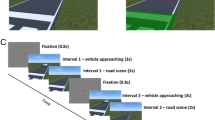Abstract
Advanced Driver Assistance Systems (ADAS) should correctly infer the intentions of the driver from what is implied by the incoming data available to it. Gaze behaviour has been found to be an indicator of information gathering, and therefore could be used to derive information about the driver’s next planned objective in order to identify intended manoeuvres without relying solely on car data. Previous work has shown that significantly distinct gaze patterns precede each of the driving manoeuvres analysed indicating that eye movement data might be used as input to ADAS supplementing sensors, such as CAN-Bus, laser, or radar in order to recognise intended driving manoeuvres. Drivers’ gaze behaviour was measured prior to and during the execution of different driving manoeuvres performed in a dynamic driving simulator. The efficacy of Artificial Neural Network models in learning to predict the occurrence of certain driving manoeuvres using both car and gaze data was investigated, which could successfully be demonstrated with real traffic data [1]. Issues considered included the amount of data prior to the manoeuvre to use, the relative difficulty of predicting different manoeuvres, and the accuracy of the models at different pre-manoeuvre times.
Access this chapter
Tax calculation will be finalised at checkout
Purchases are for personal use only
Preview
Unable to display preview. Download preview PDF.
Similar content being viewed by others
References
Lethaus, F.: Using eye movements to predict driving manoeuvres. In: Europe Chapter of the Human Factors and Ergonomics Society Annual Conference, Linköping, Sweden (2009)
German Federal Statistical Office: Unfallgeschehen im Straßenverkehr 2006 (Road Traffic Accidents 2006). Federal Statistical Office 2006-PressOffice, Wiesbaden (2007)
Dingus, T.A., Hulse, M.C., Barfield, W.: Human-system interface issues in the design and use of advanced traveller information systems. In: Barfield, W., Dingus, T.A. (eds.) Human Factors in Intelligent Transportation Systems, pp. 359–395. Lawrence Erlbaum Associates, London (1998)
Suzuki, K., Jansson, H.: An analysis of driver’s steering behaviour during auditory or haptic warnings for the designing of lane departure warning system. JSAE Review 24, 65–70 (2003)
Henderson, J.M., Ferreira, F.: Scene perception for psycholinguists. In: Henderson, J.M., Ferreira, F. (eds.) The Interface of Language, Vision, and Action: Eye Movements and the Visual World, pp. 1–58. Psychology Press, New York (2004)
Liu, A.: Towards predicting driver intentions from patterns of eye fixations. In: Gale, A.G., Brown, I.D., Haslegrave, C.M., Taylor, S.P. (eds.) Vision in Vehicles VII, pp. 205–212. Elsevier, Amsterdam (1999)
Vollrath, M., Totzke, I.: Möglichkeiten der Nutzung unterschiedlicher Ressourcen für die Fahrer-Fahrzeug-Interaktion. In: Proceedings of Der Fahrer im 21. Jahrhundert, Braunschweig (2003)
Wickens, C.D.: The structure of attentional resources. In: Nickerson, R. (ed.) Attention and Performance VIII, pp. 239–257. Lawrence Erlbaum Associates, Hillsdale (1980)
Wickens, C.D.: Processing resources in attention. In: Parasuraman, R., Davies, D.R. (eds.) Varieties of Attention, pp. 63–102. Academic Press, San Diego (1984)
Oliver, N., Pentland, A.P.: Graphical models for driver behavior recognition in a SmartCar. In: Proceedings of IEEE Conference on Intelligent Vehicles, Detroit, MI, USA (2000)
Kuge, N., Yamamura, T., Shimoyama, O., Liu, A.: A driver behavior recognition method based on a driver model framework. In: Proceedings of SAE World Congress 2000, Detroit, MI, USA (2000)
Salvucci, D.D., Boer, E.R., Liu, A.: Toward an integrated model of driver behavior in a cognitive architecture. Transportation Research Record 1779, 9–16 (2001)
Salvucci, D.D.: Inferring driver intent: a case study in lane-change detection. In: Proceedings of the HFES 48th Annual Meeting, Santa Monica, CA, USA (2004)
Anderson, J.R., Lebiere, C.: The atomic components of thought. Lawrence Erlbaum Associates, London (1998)
Lethaus, F., Rataj, J.: Do eye movements reflect driving manoeuvres? IET Intelligent Transport Systems 1(3), 199–204 (2007)
Lethaus, F., Rataj, J.: Using eye movements as a reference to identify driving manoeuvres. In: ATZ | ATZautotechnology (ed.) Proceedings of the FISITA World Automotive Congress 2008, vol. 1. Springer Automotive Media, Wiesbaden (2008)
Mourant, R.R., Donohue, R.J.: Acquisition of indirect vision information by novice, experiences, and mature drivers. Journal of Safety Research 9, 39–46 (1977)
Pastor, G., Tejero, P., Chóliz, M., Roca, J.: Rear-view mirror use, driver alertness and road type: an empirical study using EEG measures. Transportation Research: Part F 9, 286–297 (2006)
Underwood, G., Chapman, P., Brocklehurst, N., Underwood, J., Crundall, D.E.: Visual attention while driving: sequences of eye fixations made by experienced and novice drivers. Ergonomics 46(6), 629–646 (2003)
Recarte, M.A., Nunes, L.M.: Effects of verbal and spatial-imagery tasks on eye fixations while driving. Journal of Experimental Psychology: Applied 6(1), 31–43 (2000)
Rumelhart, D.E., Hinton, G.E., Williams, R.J.: Learning internal representations by error propagation. In: Rumelhart, D.E., McClelland, J.L. (eds.) Parallel Distributed Processing, vol. 1, pp. 318–362. MIT Press, Cambridge (1986)
Brophy, A.L.: Alternatives to a table of criterion values in signal detection theory. Behavior Research Methods, Instruments, & Computers 18, 285–286 (1986)
Author information
Authors and Affiliations
Editor information
Editors and Affiliations
Rights and permissions
Copyright information
© 2011 Springer-Verlag Berlin Heidelberg
About this paper
Cite this paper
Lethaus, F., Baumann, M.R.K., Köster, F., Lemmer, K. (2011). Using Pattern Recognition to Predict Driver Intent. In: Dobnikar, A., Lotrič, U., Šter, B. (eds) Adaptive and Natural Computing Algorithms. ICANNGA 2011. Lecture Notes in Computer Science, vol 6593. Springer, Berlin, Heidelberg. https://doi.org/10.1007/978-3-642-20282-7_15
Download citation
DOI: https://doi.org/10.1007/978-3-642-20282-7_15
Publisher Name: Springer, Berlin, Heidelberg
Print ISBN: 978-3-642-20281-0
Online ISBN: 978-3-642-20282-7
eBook Packages: Computer ScienceComputer Science (R0)




